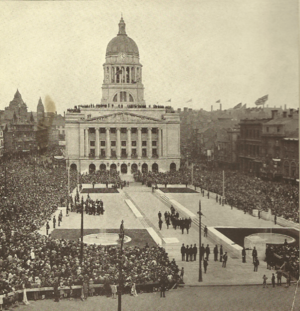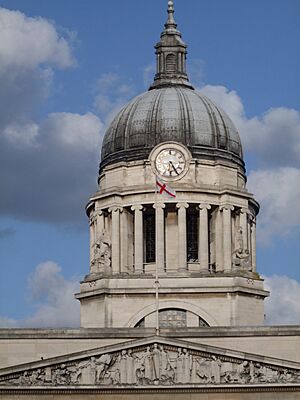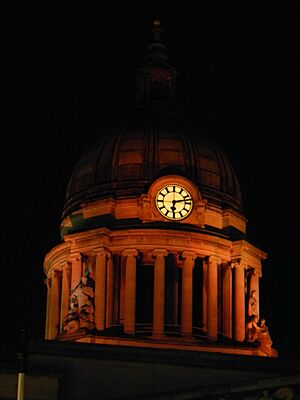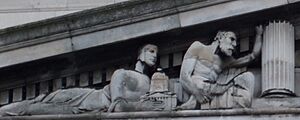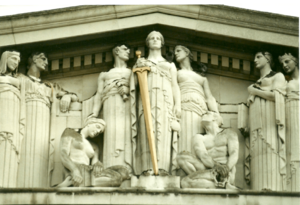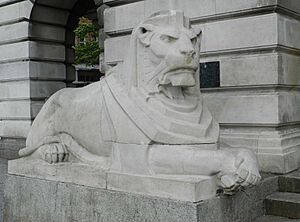Nottingham Council House facts for kids
Quick facts for kids Nottingham Council House |
|
|---|---|
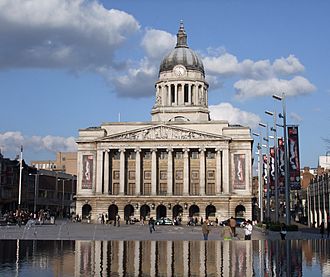
Nottingham Council House, Old Market Square
|
|
| General information | |
| Type | Municipal Headquarters |
| Architectural style | Neo-Baroque |
| Classification | |
|
Listed Building – Grade II*
|
|
| Designated: | 4 February 1988 |
| Reference #: | 1270582 |
| Location | Nottingham, England, United Kingdom |
| Address | Old Market Square, Nottingham NG1 2DT |
| Coordinates | 52°57′12″N 01°08′55″W / 52.95333°N 1.14861°W |
| Construction started | 1927 |
| Completed | 1929 |
| Client | Nottingham Corporation |
| Design and construction | |
| Architect | Thomas Cecil Howitt |
The Nottingham Council House is the main building for the city government in Nottingham, England. It's like the city's headquarters! Its tall dome, which is about 200 feet (61 meters) high, is a key part of the city's view. This grand building stands proudly over the Old Market Square, which is often called the "City Centre." It's also a special Grade II* listed building, meaning it's protected for its historical importance.
Contents
History of the Council House
The Council House was built to replace an older building called the Nottingham Exchange. It was designed by a famous architect named Thomas Cecil Howitt. He used a style called Neo-Baroque, which means it looks like old European palaces. Construction started in 1927 and finished in 1929.
Inside the bell tower, there's a huge bell nicknamed 'Little John'. It's the deepest-sounding clock bell in the United Kingdom! This giant bell weighs over 10 tonnes (about 11 tons). You can hear its chime from up to seven miles away.
The first stone of the building was laid on March 17, 1927. This was done by Alderman Herbert Bowles, who was in charge of the building project. The Council House cost a lot of money to build back then – over £500,000! The Prince of Wales, who later became King Edward VIII, officially opened the building on May 22, 1929.
Many important events have happened at the Council House. Members of the Royal Family, famous leaders, and even movie stars have visited. Trophies like the FA Cup (in 1959) and the European Cup (in 1979 and 1980) have been shown off from its balcony.
Since 2010, many council offices moved to a different building called Loxley House. So, the Council House isn't used for everyday office work as much anymore. But since 2011, it has become the main place in the city to register births, marriages, and deaths.
Outside the Council House
The Council House and the Exchange Buildings behind it are made from Portland stone. This is the same type of stone used for St. Paul's Cathedral in London!
The front of the building, which faces the Old Market Square, has eight huge columns. Above these columns, you can see 21 figures carved into the stone. These figures show different activities of the city council. They were made by Joseph Else, who was the head of the Nottingham School of Art at the time. There's also a long carving called a frieze. It shows traditional local crafts like making bells, mining, and carving alabaster.
Inside the Council House
The inside of the Council House is beautifully decorated.
Ground Floor
-
'Welcome' – statue by Sir William Reid Dick
- The Entrance Hall has shiny Italian marble on its columns, walls, and floor. In the middle of the floor, the City Arms (Nottingham's official symbol) are inlaid as a mosaic.
- Bronze plaques on the walls list important people who have been honored by the city. One plaque remembers the building's opening in 1929 and even shows the golden key used by the Prince of Wales!
- A grand, curving marble staircase leads up to the main rooms on the first floor. At the top of the stairs, there's a bronze statue called 'Welcome' by Sir William Reid Dick. It shows a female figure with open arms, greeting visitors.
First Floor
- The Ballroom looks a lot like a room in the famous Palace of Versailles in France. It has golden columns and a very fancy ceiling. The special wooden floor is made for dancing. Large windows open onto the famous balcony overlooking the Old Market Square.
- The Dining Room is used for smaller events. It has beautiful wooden walls and a marble fireplace. A large portrait of Queen Elizabeth II hangs in this room.
- Display cabinets here show off the city's ceremonial maces (special staffs) and silver gifts given by important visitors.
- The Lord Mayor's Suite is a special area for the Lord Mayor. It includes a Parlour with carved wooden walls and a Sitting Room with oak panels.
Second Floor
- The Committee Room has a large, horseshoe-shaped table. This is where many important meetings used to happen before the council moved some of its operations.
- The Sheriff's Parlour is decorated in a classic style.
Third Floor
- The Tea Room can hold up to 30 people. It has a big wooden table that used to be in the headquarters of a famous bicycle company called Raleigh Industries.
- The Members' Room is a space for councillors. It has newspapers, computers, and a television. You can also find old records of city council meetings here.
- The Council Chamber takes up most of the third floor. This is where the main city council meetings are held. The seats are arranged in a semicircle. Above the Lord Mayor's seat, there are two Latin sayings. They mean: "Laws are made for the welfare of the citizens and the city" and "It is the highest justice to give each man his due." The walls are made of wood, and special fabric panels help the room sound good. There's a separate entrance for the public to watch meetings.
The Dome and Clock
The dome is the most noticeable part of the Council House and a symbol of Nottingham. A fancy top part, called a cupola, sits on top of the dome. The very top of the cupola is 200 feet (61 meters) above the Old Market Square.
Behind the clock face is the clock's machinery. It was made by a famous clockmaking family called Cope. The clock face is 9 feet (2.7 meters) wide and is 150 feet (46 meters) above the ground. The clock has a pendulum that is 13 feet (4 meters) long! It still needs to be wound by hand once a week.
Four bells play the famous Westminster Chimes every 15 minutes. The main hour bell has been called 'Little John' since the building opened. This bell was made in 1928 by the world-famous bellfounders John Taylor & Co. 'Little John' is one of the heaviest bells they ever made and one of the heaviest in the British Isles. Its deep E-flat tone is the deepest for a clock bell in the British Isles. When the bells first started ringing, some people complained about them ringing all night. So, in 1929, the council decided the chimes and strikes should stop between 11:00 PM and early morning.
The Exchange (Shopping Arcade)
The ground floor of the Council House is a fancy shopping mall called 'The Exchange'. It was named after the old Nottingham Exchange building. Many local people still call it the Exchange Arcade. Shops were included in the building's design to help pay for its construction during the Great Depression. The council owned this shopping area until 1985 when it was sold and turned into the shopping center we see today.
This part of the building is now privately owned. Each shop has its own basement for storage. Deliveries are made through an underground road, using a special lift. This area used to be a fresh produce market.
Underneath the Council House dome, there are beautiful painted murals. These large paintings show important moments from Nottingham's history:
- The Danes capturing Nottingham in 868.
- William the Conqueror ordering the building of the castle in 1068.
- Robin Hood and his Merry Men.
- King Charles I starting the Civil War in 1642.
These murals were painted by a local artist named Noel Denholm Davis. He even used local famous people as models! For example, the architect T. Cecil Howitt appears as William the Conqueror's surveyor. The famous football goalkeeper Albert Iremonger posed as Little John. Around the base of the dome, an inscription reads: "The Corporation of Nottingham erected this building for counsel and welcome, and to show merchandise and crafts."
Over the years, these murals got damaged by water. The Robin Hood mural was especially affected. But in June 2018, Nottingham City Council finished a complete restoration of the damaged murals, making them look new again.
Statues and Sculptures
Many of the statues and sculptures on the outside of the Council House were created by Joseph Else. He was the head of the Nottingham School of Art. Else made the famous lions at the entrance, the carvings above the Ballroom windows (showing old local industries), and the figures on the main front of the building (showing arts and public service). There's even a pub near the square named after him!
The Lions
The two large art-deco lions were also created by Joseph Else. They each weigh about 2 tonnes (2.2 tons) and stand guard on either side of the entrance steps. Joseph Else named them ‘Agamemnon’ and ‘Menelaus’, after two kings from Greek mythology. But many local people call them 'Leo' (the left one) and 'Oscar' (the right one). People often say, "Meet you by the lions" (usually the left one), and it's a common meeting spot in Nottingham.
Sculpture Groups around the Dome
These large sculptures around the dome were made by Joseph Else and three of his former students from the School of Art. All the sculptors grew up in Nottingham.
- Commerce by Joseph Else. This sculpture shows two male figures pushing a ship, with a female figure holding a caduceus (a symbol of trade). You can see this one near the Exchange Walk.
- Civic Law by Charles L J Doman. A smiling female figure holds a scepter and a book. At her feet are figures representing Law and Justice. This group is at the Long Row / King Street corner.
- Prosperity by James Woodford. This sculpture has a strong Art-Deco style. A female figure holds a sword, and at her feet are a mother and baby, and another female holding fruits. You can see this at the Long Row East corner. James Woodford is famous for creating the heraldic Queen's Beasts for Queen Elizabeth II's coronation.
- Knowledge by Ernest Webb. A female figure wearing a 1920s hat holds a globe. Two male figures sit at her feet, one with a book and the other with a pair of compasses.


